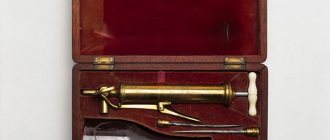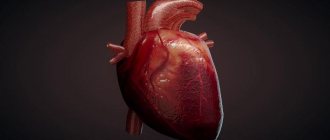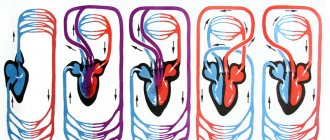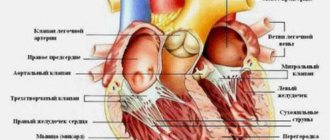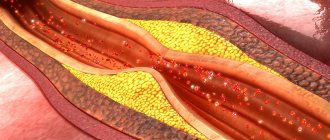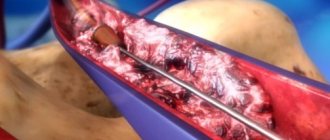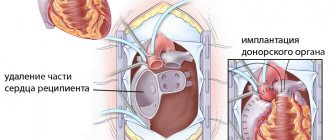Circulation is the movement of blood in the human body. It consists of three main parts: blood, blood vessels (arteries, veins, capillaries) and the heart.
We decided to prepare educational material so that each of you is aware of all the nuances of the cardiovascular system. This is important so that you can understand in time what problem you could or may encounter in the future, and also so that the terminological expressions of our specialist during a face-to-face consultation do not seem like a foreign language to you.
Circulation circles
The blood flowing through the cardiovascular system can be compared to an athlete running different distances. When it passes through the pulmonary circulation, it is a sprint. And a big circle is already a marathon. The Englishman William Harvey described these circles back in 1628. During a large circle, blood is distributed throughout the body, not forgetting to provide it with oxygen and take away carbon dioxide. During this “race”, arterial blood becomes venous.
The pulmonary circulation is responsible for the flow of blood into the lungs, where the blood releases carbon dioxide and is enriched with oxygen. Blood from the pulmonary circulation returns to the left atrium. The systemic circulation, starting in the left ventricle, transports blood throughout the body. Oxygenated blood is pumped by the left ventricle into the aorta and its many branches - the various arteries. Then it enters the capillary vessels of organs and tissues, where oxygen from the blood is exchanged for carbon dioxide. The systemic circulation ends in small veins that merge into two large veins (vena cava) and return blood to the right atrium. The superior vena cava drains blood from the head, neck and upper extremities, and the inferior vena cava drains blood from the torso and lower extremities.
Physiology/hemodynamics
Normally, oxygenated blood leaves the left side of the heart through very large arteries. Which then branch into smaller and smaller arteries, then into arterioles and capillaries, which penetrate all organs and tissues of the human body. They are visible only under a microscope. The capillary bed connects the smallest arteries (arterioles) with the smallest veins (venules). Capillaries are very small vessels with very thin walls, thanks to which oxygen and nutrients easily flow from the blood into the tissues of the body. The tissues, in turn, release carbon dioxide and various waste products into the blood, which returns through the veins to the heart (Figure 1).
Picture 1.
Blood from the heart enters the large arteries (indicated in red), then it flows into smaller arteries and arterioles of the upper and lower extremities, as well as other organs and systems of the human body. Then the blood enters a network of tiny vessels - capillaries, which penetrate all human tissues and organs. The blood releases oxygen and various nutrients, and then returns through the veins (highlighted in blue) to the heart.
The venous system of the lower extremities consists of superficial and deep veins. Deep veins are large vessels through which the bulk of the blood moves due to the work of muscles. Superficial veins are smaller vessels that collect blood from the skin and subcutaneous tissue, and, due to the work of venous valves, move it upward, back to the heart. The superficial and deep veins communicate with each other through communicating or perforating veins, which are also equipped with valves. It is due to the operation of the valves that blood moves from the bottom up and from the superficial veins to the deep ones; such one-way movement is the key to the proper functioning of the veins.
Regulation of blood flow through the vessels is carried out by the nervous, endocrine system, as well as local vasoactive substances produced in tissues. This complex regulation allows blood flow to increase or decrease depending on the body's needs, for example, increased blood flow in the muscles during exercise, and decreased at rest. By changing the tone of skin vessels, body temperature is regulated. When it is cold, the blood vessels in the skin constrict, blood moves closer to the center of the body, due to this mechanism the body retains heat. On the contrary, when it is hot, the blood vessels in the skin dilate and the body gives off more heat. Various body injuries and injuries trigger processes that can cause blood flow to increase or decrease, for example, in the area of a skin burn or in a sprained area.
The walls of the veins are very thin and pliable, so the venous system can change its capacity to accommodate different amounts of blood. Blood volume is proportional to the pressure inside the veins. When the amount of blood in the veins decreases or its pressure on the vein walls decreases, the veins collapse like an empty balloon. When the volume of blood or its pressure on the walls of the vein increases, the veins expand, like an inflated balloon. If the pressure in the veins becomes very high, the venous wall stretches, its permeability increases and the vein allows fluid to pass through, which rushes into the tissue. This is how swelling occurs.
To maintain normal blood circulation in the body, the following 4 components are very important:
- Normal functioning of the heart, which, when contracting, works like a pump
- Pressure gradient between areas of low and high venous pressure
- “Muscular-venous pump” - the muscles of the lower extremities contract and work like a pump, pushing blood to the heart
- Normal, non-dilated, completely patent veins, with functioning venous valves
(1) The heart is the main pump of the human circulatory system. Blood moves through the arteries due to rhythmic heart contractions. It is important to understand that venous blood, after returning to the heart, must be pumped to the lungs, where it is enriched with oxygen. If the vein does not perform this function, as happens with heart failure, then venous blood stagnates and edema can appear even with absolutely normal veins.
(2) According to the laws of physics, any liquid moves from a high pressure zone to a lower pressure zone. The pressure difference between different zones is called gradient. There are such zones in the human body, thanks to which blood can move against the force of gravity. For example, the pressure in the veins of the lower extremities is higher than in the veins of the pelvis and abdominal cavity, and in the right parts of the heart it is even lower and may even be negative, which is why venous blood moves towards the heart. With some diseases of the lungs and heart, the pressure in the right parts of the heart may be increased, which can also lead to edema.
(3) “Muscular-venous pump” - like the heart, which pumps blood through the arteries, the muscles of the lower extremities contract to pump blood through the veins. The most important muscles performing the pumping function are the gastrocnemius muscles. There is also a venous network in the foot area; the muscles and ligaments of the foot also act as an additional pump. With each step, the muscles of the foot and lower leg contract rhythmically, pushing blood through the veins towards the heart, overcoming the effects of gravity. If a person leads a sedentary lifestyle and there is not enough activity in his life, the muscular-venous pump ceases to function normally and edema may appear. It can also occur as a result of injury or after a stroke. Sometimes the gait of older people changes, it becomes shuffling, the old people seem to shift from one foot to another. In this case, the muscular-venous pump also stops working and swelling may appear.
(4) Most veins in the human body are equipped with valves that allow blood to flow in only one direction. For the normal functioning of the venous system, the valves must be intact, that is, not damaged, and functioning correctly. As a result of contraction of the leg muscles, a portion of blood moves up through the veins, the valves allow blood to pass upward, and immediately close. They work like the rungs of a ladder, allowing blood to move forward towards the heart.
Figure 2.
The work of the “muscular-venous pump” is similar to a pump that pumps blood from the lower extremities to the heart. Due to the many valves with which the veins of the lower extremities are equipped, blood moves only in one direction: from the more superficial layers to the deep ones and from bottom to top, towards the heart. (a) When muscles contract, blood is forced out of the veins and moves upward. (b) When the muscles relax, the valves close, preventing blood from flowing back.
Each venous valve consists of two thin elastic flaps located opposite each other, opening and closing synchronously. If the vein dilates more than normal, as happens with varicose veins, the valve flaps cannot close and block the lumen of the vein, as a result, the blood moves in the opposite direction - this is called reflux. The flow of blood through a vein can also be disrupted if a blood clot forms that blocks the lumen of the vein. In both cases, venous pressure increases significantly, the vein wall becomes thinner as it stretches, and the liquid part of the blood seeps into the tissue, causing swelling. Edema is one of the main signs (symptoms) of improper functioning of the venous system.
If venous outflow is disrupted for a short time, for example after an air flight or prolonged static exercise, the main manifestation is swelling, which completely disappears overnight. If venous edema persists for a long time, for months, the skin and subcutaneous tissue begin to change, thickening and darkening may appear in the lower leg area, and subsequently infection, erysipelas, and microbial eczema may occur. All this can lead to the formation of long-term non-healing trophic ulcers.
Arteries
Not a single cell can survive without nutrients and oxygen. They are delivered by arteries. They carry oxygen-rich blood throughout the body. When you breathe, oxygen enters your lungs. where the delivery of oxygen throughout the body begins. First to the heart, then through the systemic circulation to all parts of the body. There, the blood exchanges oxygen for carbon dioxide and then returns to the heart. The heart pumps it back to the lungs, which take in carbon dioxide and give out oxygen, and so on endlessly. There are also pulmonary arteries of the pulmonary circulation, they are located in the lungs and through them blood, poor in oxygen and rich in carbon dioxide, enters the lungs, where gas exchange occurs. This blood then returns to the heart through the pulmonary veins.
How blood clots block veins and damage valves
Blood clots form in a vein just as a dam forms in a river bed. Just like water floods fields during a flood. Swelling of the leg also occurs due to thrombosis, and just like fields, it can only be drained through streams outside the main riverbed. Over time, changes occur and these small venous channels enlarge and protrude through the skin, increasing blood flow. This explains why a person who has had deep vein thrombosis has dilated saphenous veins. In some cases, these veins are mistaken for varicose veins, and if the valves in these veins work normally and they are removed, the condition of the leg may worsen. That is why any person needs an ultrasound duplex scan before undergoing surgery for varicose veins after deep vein thrombosis. Since the small outflow channels are enlarged, leg swelling decreases. At the same time, several mechanisms occur in the thrombosed vein and the blood clots are broken down through a process called thrombolysis.
What problems does scarring of veins cause?
First of all, this leads to leg pain and swelling. If the valves in the deep veins are damaged, blood flows in the opposite direction - to the foot. This causes an increase in pressure in the vessels at the ankle level, which leads to swelling. Many people with incompetent deep vein valves after venous thrombosis (the valves don't work) have pain when standing up. And this pain intensifies during the day and goes away if the person lies down again. Some people experience a feeling of blood overflowing in the lower leg due to incompetence of the deep veins.
Features of blood flow in the organs of the systemic circle
Some of the internal organs have their own characteristics. So, for example, in the liver there is not only a hepatic vein, which “carries” the venous flow away from it, but also a portal vein, which, on the contrary, brings blood to the liver tissue, where blood purification is performed, and only then the blood collects in the tributaries of the hepatic vein to enter to a big circle. The portal vein brings blood from the stomach and intestines, so everything that a person eats or drinks must undergo a kind of “purification” in the liver.
In addition to the liver, certain nuances exist in other organs, for example, in the tissues of the pituitary gland and kidneys. Thus, in the pituitary gland the presence of a so-called “wonderful” capillary network is noted, because the arteries that bring blood to the pituitary gland from the hypothalamus are divided into capillaries, which then collect into venules. The venules, after the blood with the molecules of releasing hormones are collected, are again divided into capillaries, and then veins are formed that carry the blood from the pituitary gland. In the kidneys, the arterial network is divided twice into capillaries, which is associated with the processes of excretion and reabsorption in the kidney cells - in the nephrons.
What can happen if postthrombotic syndrome occurs?
Changes in the skin occur, the addition of induration, eczema, hyperpigmentation and, as a finale, trophic ulcers are sometimes very large, and the leg may look like an inverted bottle of champagne. What can help? The best thing is to prevent possible deep vein thrombosis. But it’s like the proverb: “It’s better to be rich and healthy than...”. If you have postthrombotic syndrome, only three treatment methods can help: compression
(compression stockings, tights, bandages, in combination with specially designed physical therapy),
drug therapy
(phlebotonics and disaggregants) and valve surgery (various options
for restoring the valve apparatus
with preventing the discharge of blood through incompetent perforating veins). No other methods have yet been invented. In order to help patients with post-thrombotic syndrome, knowledge, patience and modern treatment methods are needed - this is, first of all, a method of restoring the valve apparatus through a low-traumatic operation without the use of incisions. We are ready to help you.
Vessels
Arteries are vessels that deliver blood from the heart to the organs. The arterial system, which permeates the entire body, includes the arteries of the heart, pulmonary, renal, splenic arteries, aorta, brachiocephalic arteries, arteries of the extremities, etc. Since the arteries need to withstand considerable blood pressure, their walls are initially elastic and elastic. However, as a result of atherosclerosis, the walls of the arteries are weakened. Impaired elasticity of the walls of blood vessels and a decrease in the lumen inside the arteries lead to heart failure and coronary heart disease. As a result of the changes, the arterial walls become stratified and aneurysms form on them. Such ailments are dangerous, because disruption of just one link in the chain of the cardiovascular system will lead to pathological processes inside the body.>
Capillaries are vessels that connect the arterial and venous systems. Thanks to these thinnest vessels, blood and tissues exchange substances with each other. Capillaries permeate tissues that need oxygen.
Veins are vessels that carry blood obtained from capillaries to the heart.
Heart
The heart is the organ that pumps blood from the veins to the arteries. Thanks to the work of the heart, blood is supplied to the organs through arteries and capillaries. It is like a powerful pump and consists of muscle tissue - the myocardium. The heart pumps about 5 liters of blood per minute. An abrupt stop in its work is fraught with fatal consequences - myocardial infarction or heart attack often ends in the death of a person.
